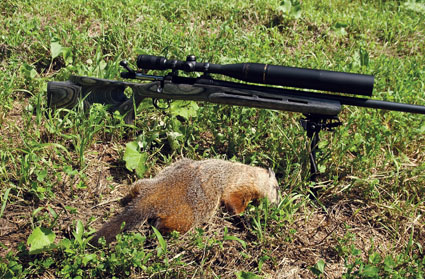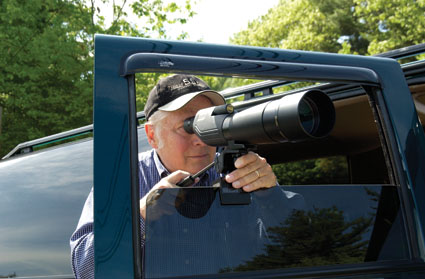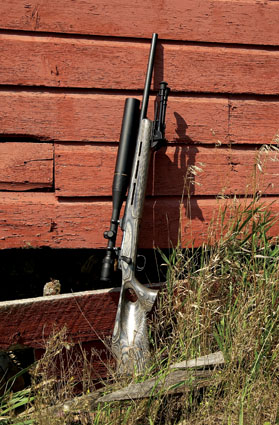If you want to broaden your hunting skills for the autumn hunting season, the Eastern woodchuck is a good critter to do it with. I’ve been at it since I was a youngster on the farm and still look forward to chuckin’ each year as warm weather approaches.
For most of us, it’s the in-between time right after good fishing days and before cooler air brings on the big-game seasons. You’re giving coyotes and other predators time to raise the next crop, and there really isn’t much to hunt this time of the year. Woodchucks start to look pretty good around the dog days of summer.
Woodchucks provide a great alternative to the warm-weather doldrums, and a little scouting usually finds folks in the country eager to dispose of them. Driving through northern Pennsylvania and New York, for example, finds rustic farmhouses surrounded by rolling fields of clover. A query at a landowner’s front door usually opens chuck-hunting opportunities around the farm.
Timing
Often, the lady of the house will tell you chucks are eating up her garden. A closer look shows that, indeed, the hole leads on a well-beaten trail to the lettuce patch. She might also point you to the equipment shed, where chucks love to den up around the soft dirt and heavy timbers under the older buildings.
For close shooting around sheds and walls, it’s a good idea to pack a rimfire rifle or handgun along with your centerfire rifle. However, the most enjoyable way to hunt these rodents is in open fields, right after the first and subsequent cuttings, usually about two weeks after the mower has left and the new grass is tall enough to hide a chuck as it scurries about his daily routine.
This is also a prime time to hunt as the new batch of juveniles are matured. Their appetites grow huge in order to pile on a thick layer of fat to survive the coming winter. A normal adult chuck can eat its way through an acre of prime field grass in a season, and they are most active at this latter part of the summer. Permission to take them out is not hard to get.
 Chucks are most active in early morning or late afternoon. If their burrows are away from a good source of water, they will gain moisture from the early morning dew. Although chucks can be seen during any part of the day, overcast days increase a hunter’s chances of making contact during midday. As the afternoon cools, the varmints start moving again, to stretch and resume feeding.
Chucks are most active in early morning or late afternoon. If their burrows are away from a good source of water, they will gain moisture from the early morning dew. Although chucks can be seen during any part of the day, overcast days increase a hunter’s chances of making contact during midday. As the afternoon cools, the varmints start moving again, to stretch and resume feeding.
By nature, chucks are lazy and can be spotted around any field, often in the most unlikely places. Stone walls and even low-lying tree limbs or logs are a natural haven for chucks on balmy summer days. When checking stone walls or hedgerows made with field stones, never be in a hurry. Glass carefully around the perimeter of a new field. Chucks are brown to gray-brown in color, blending in with their surroundings. A chuck napping on top of a wall could easily be mistaken for just another rock on the pile.
I’ve shot woodchucks right out of the crotch of a large tree, so search high and low. Take your time, let your eyes adjust to the deep shadows and look for any sign of movement. Chucks will find refuge in woodpiles, rock piles (be careful of ricochets), on the tops of older logs or even within the boundaries of mid-field islands.
The Best Techniques
When it comes to hunting woodchucks, you can develop your own style. Some hunters choose a heavy-barrel varmint rig, settle down on a bipod and sit for the day, and watch the tree line waiting for a chuck to appear.
My favorite method is walking fields with a lightweight rifle topped off with a 3-9x or 4-12x scope. Armed with a pocketful of cartridges, a good binocular, the rifle on a sling, a hat, and some snacks and water, and I'm ready for a few hours of hiking the fields.
As in any hunting foray, cover is the secret of success. While those who don’t know better might think \ this animal is stupid, that’s far from the truth. They spook at the faintest wisp of movement or a glint or reflection off a rifle, so it’s a good idea to stay away from shiny rifles and scopes. Built close to the ground, woodchucks can surprise you with how fast they can disappear into their strategically placed dens. In addition, if you shoot and miss, forget it, because in most cases the critters never pop out of the same hole within any reasonable amount of time.
 Because of ever-expanding coyote populations, woodchucks don’t populate the average field in numbers as large as they did in days gone by, but there usually are at least some around and you’ll find them if you know where to look. In years past, it was common to see several mounds of chuck diggings scattered across any field of reasonable size.
Because of ever-expanding coyote populations, woodchucks don’t populate the average field in numbers as large as they did in days gone by, but there usually are at least some around and you’ll find them if you know where to look. In years past, it was common to see several mounds of chuck diggings scattered across any field of reasonable size.
Today, chucks have evolved to the point where they now den up close to stone walls to protect their rear from attack. I’ve also noted that they will limit themselves to shorter distances from their safe zone in order to get back to their den quicker if a predator appears.
Stalking chucks is much like stalking any other game, but be especially stealthy in the latter part of the summer if the ground is dry and noisy. Frequently, a “lane road” parallels the field; usually a dirt road that runs on either side of the pasture where the farmer transports his tractor and equipment to work in the field. This is a perfect travel route for chuck hunters as the deep shadows of the tree line help keep you quieter and out of sight and offers impromptu rifle rests.
Keep low, crawl or creep toward the edge of the field and be ready for a quick shot. Sometimes you might be offered a head shot, and rarely a body shot. Since you will most often be carrying a flat-shooting .22 rifle or handgun, just place the crosshairs on the chuck and pull the trigger — presuming the range is moderate.
Tools You’ll Need
Choosing the right equipment is half the pleasure, regardless of the game hunted. Small-caliber rifles are a personal obsession and anything from the sizzling 17s to more traditional .22s work for me. I prefer common, off-the-shelf, sporter-weight rifles with either a 22- or 24-inch barrel. In the Northeast, chuck-shooting distances average 250 to 300 yards. Considering the accuracy of modern rifles and the ample girth of a woodchuck, just about any make of rifle will do the job.
 I prefer an adjustable trigger tuned down to around 2½ to 3 pounds. Anything that will shoot one-minute-of-angle or better with factory ammon or handloads is fine for chucks. Single-shot rifles make hunting a challenge, especially if you and your partner engage in a “one-shot-per-chuck” hunt to spice up the day.
I prefer an adjustable trigger tuned down to around 2½ to 3 pounds. Anything that will shoot one-minute-of-angle or better with factory ammon or handloads is fine for chucks. Single-shot rifles make hunting a challenge, especially if you and your partner engage in a “one-shot-per-chuck” hunt to spice up the day.
Cartridge choice is expansive. The .17 Remington is a pleasure to use because of its low recoil, and it’s sensational on chucks out to 100 yards. It will reach farther, but if the wind is blowing, the .20s or .22s do a better job at longer range. The .204 Ruger is another favorite of mine.
The .22 family offers several options. The .222, 223 and .22/250 cartridges are popular, and a pet of mine, the .224 Weatherby (complete with its slimmed down Mark V action) still resides in a place of honor in my truck. The .221 Fireball is back, chambered in the Remington Model 700, as is the newest offshoot, the .17 Remington Fireball. They’re both super on chucks.
Hunting Steeped In Tradition
Many early wildcat rounds were developed specifically for the woodchuck hunter, including the Donaldson Wasp and the K-Hornet. Using them brings an element of nostalgia to the hunt. With one of those venerable old-timers, you’re stepping into the boots of legends of the early days of wildcatting.
Over the years, my collection has grown to include numerous Ruger No. 1s, Thompson/Center Encores and a few Remington 700s chambered for these cartridges. For instance, I have a super-accurate Thompson/Center chambered in the .22 K-Hornet from the T/C Custom Shop. This is nothing more than the common .22 Hornet with the shoulder moved back that you can actually fire-form right in the chamber of the host gun.
I’ve used the .19 Calhoon, a Cooper .17 Mach IV, a .218 Mashburn Bee and a .219 Donaldson Wasp — a cartridge developed by Harvey Donaldson in the area where I hunt in New York. The .22/250 Remington pushed it out of the limelight, but nevertheless, every time I hunt the Empire State I can feel ol’ Harve looking over my shoulder. The list goes on, including a .220 Weatherby Rocket, the mostly forgotten .225 Winchester, the .22 Remington BR, and a .20 VarTag, which is a .221 Fireball case necked down to .20 caliber.
Chuck hunting with vintage cartridges or the latest whizzers is all good summertime shooting activity and provides excellent practice. It’s a sport as American as Chevrolet and mom’s apple pie. It offers great opportunity for off-season hunting, allows the use of a host of cartridges of modest power, and — the bottom line — it’s just plain fun!






